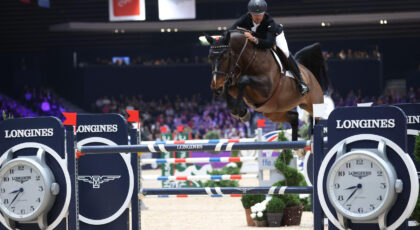The word “fascia” has been bouncing around now for a number of years, but it still isn’t a term that’s commonly dropped in horsey circles. We are learning, however, that equestrians should be more attentive to the “fascia trend”—training fascia has distinct repercussions on our riding ability and general athleticism.
“Fascia is often described as the ‘cling-film’ that wraps our muscles,” explains biomechanics pioneer Mary Wanless in her book The New Anatomy of Rider Connection. “You have probably seen it as the white film that surrounds the muscles of a chicken leg, or as the white lines dividing a joint of beef into segments, but fascia is so much more than this. It is a body-wide net that wraps not just muscle, but also every bodily organ, reaching from your skin to your bones. And it does not just wrap—this net pervades and invests nearly every nook and cranny with a kind of three-dimensional spider’s web that keeps us and our cells together in recognizable form.”
The first step in knowing how to train our fascia is recognizing what “type” we are. Here’s how Wanless describes it in her book.
***
Talented riders have their fascial net tensioned in just the right way; but how much of that is inborn and how much is learned?
Researchers have only recently begun to study constitutional differences in fascia, and we can observe a spectrum of tightness or laxity in the fascial net of different people. We can make an amusing simplification by talking about “Viking fascia” and “Temple dancer fascia.” People with Viking fascia have a naturally stiffer fascial netting, while those with Temple dancer fascia have a naturally looser net. How you need to train depends on what kind of fascia you have.

Illustration by Manoj Bhargav and Inger Recht.
Although there are formal tests, an easy way to tell where you are on this spectrum is to flex your wrist to 90 degrees, and then use your other hand to bend your thumb down to your forearm. If it comes close or touches, you are a Temple dancer. If it is still far away at full stretch, you are a Viking type. Neither is wrong or right, but it is good to know where you lie on this spectrum.
Vikings tend to love weight training and heavy work, whilst Temple dancers are often drawn to yoga and dance. In fact, both extremes actually need the opposite: Vikings will benefit from deep stretching, and Temple dancers will benefit from high muscle tone and oppositional balance in muscle groups. If you are Temple dancing rider, you might find joint stability hard to come by, as it far too easy to “wiggle in the middle” as you attempt to sit the trot! A Viking rider will tend to be more stable, but might struggle to find the fluidity of easy sitting.

©Peter Dove
Age may be less kind to sedentary Vikings, but of course both types are subject to injury. When you cut your skin, the biochemistry of inflammation triggers the fibroblasts that manufacture collagen to transform into myofibroblasts, which can contract. This is nature’s ingenious way of pulling the sides of the wound together to facilitate healing, and the resulting mechanical tension in the fascial net causes even more cells to become myofibroblasts. If the body overreacts and scar tissue is formed, this pulls on the fascial net even more strongly, in a process that causes yet more fibroblasts to become capable of contracting.
These changes also take place after injuries, like falls, that have not damaged the skin. It could be weeks after a traumatic event before you or your horse become noticeably stiff, with the body part most obviously affected being far from the site of the original injury. Unfortunately, myofibroblasts do not return to their original form—they remain contractile until they die and are replaced by new fibroblasts.

©Peter Dove
Acupuncturists will tell you that they, as well as bodyworkers, have some of the best answers to this cycle, with their needles influencing the fascial net to reduce the pain and stiffness that this process creates.
Crucially for us and our horses, recent research has shown that fascia is the mechanism by which tensional force is transmitted through the body (compression goes through the bones and joints). This means that fascia is fundamental to stability. Good work on rider biomechanics trains fascia so that we become more stable as a whole, while also becoming more able to respond appropriately to small (and big) changes in our horses.
***

This excerpt from The New Anatomy of Rider Connection by Mary Wanless is reprinted with permission from Trafalgar Square Books (www.horseandriderbooks.com).




 April 24, 2018
April 24, 2018 




























